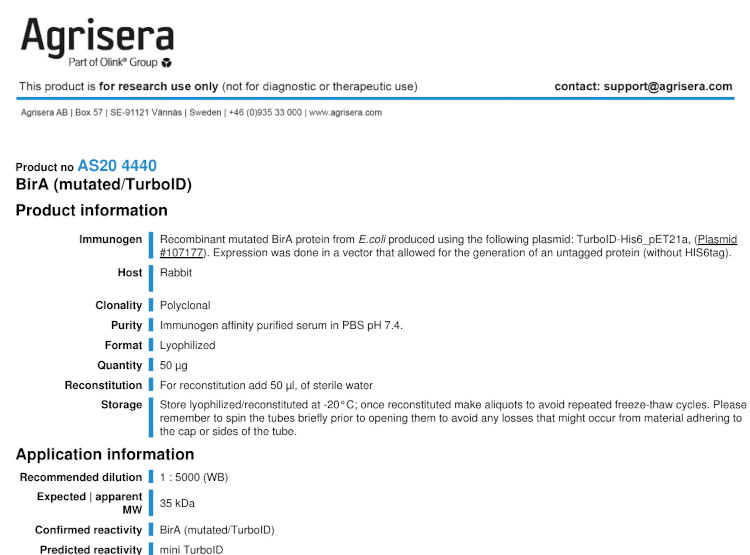| Protein-protein interactions in crop plants can be studied using transient TurboID-based proximity labeling. In the recent publication "Protocol to identify protein-protein interaction networks in Solanum tuberosum using transient TurboID-based proximity labeling" from the Laboratory of Plant Breeding, Wageningen University & Research, The Netherlands, authors Li Shi et al. described the methodology of transient expression of constructs of a protein under investigation, fused to TurboID, and the identification of protein-protein interactions in potato leaves. The publication describes a detailed protocol for preparation of plant material and transgene desing, as well as protein identification, using Agrisera's anti-TurboID antibody (AS20 4440). The authors also discuss limitations of the protocol, and provide suggestions on how to adress them. Steps of the protocol include:
|  |
Latest
Agrisera participates and supports several conferences in 20262025-12-29 Interview with Assoc. Prof. Nico Blanco
2025-12-23 2025 Highlights!
2025-12-22 We wish you all a wonderful holiday season and a bright start to 2026!
2025-12-19 Interactive workshop focused on antibodies and Western blot held at the University of Wrocław, Poland
2025-12-12 Interview with Prof. Debabrata Laha
2025-12-10 Agrisera Prize at Umeå Plant Science Centre 2025
2025-12-05 Interview with Assistant Prof. Ivan Radin
2025-11-27 Agrisera last shipment date in 2025
2025-11-24 Agrisera supports Canadian Society of Plant Biologists Western Regional Meeting
2025-11-21
Archive
- December - 2025
- November - 2025
- October - 2025
- September - 2025
- August - 2025
- July - 2025
- June - 2025
- May - 2025
- April - 2025
- March - 2025
- February - 2025
- January - 2025
- December - 2024
- November - 2024
- October - 2024
- September - 2024
- August - 2024
- July - 2024
- June - 2024
- May - 2024
- April - 2024
- March - 2024
- February - 2024
- January - 2024
- December - 2023
- November - 2023
- October - 2023
- September - 2023
- August - 2023
- July - 2023
- June - 2023
- May - 2023
- April - 2023
- March - 2023
- February - 2023
- January - 2023
- December - 2022
- November - 2022
- October - 2022
- September - 2022
- August - 2022
- July - 2022
- June - 2022
- May - 2022
- April - 2022
- March - 2022
- February - 2022
- January - 2022
- December - 2021
- November - 2021
- October - 2021
- September - 2021
- August - 2021
- July - 2021
- June - 2021
- May - 2021
- April - 2021
- March - 2021
- February - 2021
- January - 2021
- December - 2020
- November - 2020
- October - 2020
- September - 2020
- August - 2020
- July - 2020
- June - 2020
- May - 2020
- April - 2020
- March - 2020
- February - 2020
- January - 2020
- December - 2019
- November - 2019
- October - 2019
- September - 2019
- August - 2019
- July - 2019
- June - 2019
- May - 2019
- April - 2019
- March - 2019
- February - 2019
- January - 2019
- December - 2018
- November - 2018
- October - 2018
- September - 2018
- August - 2018
- July - 2018
- June - 2018
- May - 2018
- April - 2018
- March - 2018
- February - 2018
- January - 2018
- December - 2017
- November - 2017
- October - 2017
- September - 2017
- August - 2017
- July - 2017
- June - 2017
- April - 2017
- March - 2017
- February - 2017
- December - 2016
- November - 2016
- October - 2016
- September - 2016
- August - 2016
- July - 2016
- June - 2016
- May - 2016
- April - 2016
- March - 2016
- February - 2016
- January - 2016
- December - 2015
- November - 2015
- October - 2015
- September - 2015
- August - 2015
- July - 2015
- June - 2015
- May - 2015
- March - 2015
- February - 2015
- January - 2015
- December - 2014
- November - 2014
- October - 2014
- September - 2014
- August - 2014
- July - 2014
- June - 2014
- May - 2014
- April - 2014
- March - 2014
- February - 2014
- January - 2014
- December - 2013
- November - 2013
- September - 2013
- August - 2013
- July - 2013
- June - 2013
- May - 2013
- April - 2013
- February - 2013
- January - 2013
- December - 2012
- October - 2012
- September - 2012
- August - 2012
- July - 2012
- June - 2012
- May - 2012
- April - 2012
- March - 2012
- December - 2011
- November - 2011
- September - 2011
- August - 2011
- July - 2011
- April - 2011
- January - 2011
- December - 2010
- October - 2010
- September - 2010
- August - 2010
- July - 2010
- March - 2010
- January - 2010
- December - 2009
- November - 2009
- September - 2009
- July - 2009
- June - 2009
- May - 2009
- March - 2009
- January - 2009
- December - 2008
